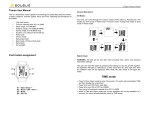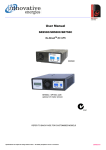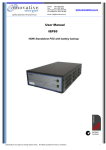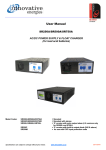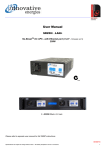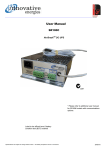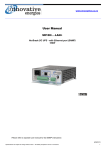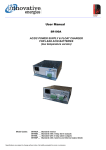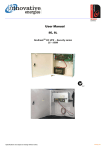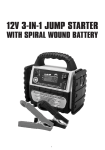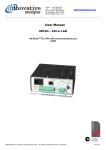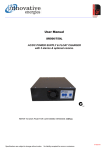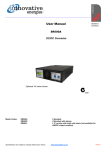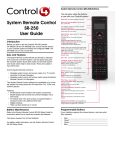Download SR250J User Manual.pub
Transcript
+64 9 835 0700 0800 654 668 (New Zealand) 1800 148 494 (Australia) +64 9 837 3446 [email protected] www.innovative.co.nz 1 Heremai Street, Henderson, Auckland, New Zealand PO Box 19-501, Auckland 1746, New Zealand Phone: Freephone: Fax: Email: Online: In Person: By Post: Innovative Energies Limited Innovative Energies' liability under this warranty is limited to the replacement or repair of the defective product as long as the product has not been damaged through misapplication, negligence, or unauthorized modification or repair. Innovative Energies Ltd warrants its power supplies for 24 months (two years) from date of shipment against material and workmanship defects. TERMS OF WARRANTY Sincerely, The Innovative Energies team. We trust your power supply will exceed your expectations and perform for years to follow. Thank you for purchasing from Innovative Energies. Global Solutions Personal Focus www.innovative.co.nz Specifications are subject to change without notice. No liability accepted for errors or omissions. Label to be affixed here if battery condition test (BCT) enabled 1 7/01/2011 4:29 p.m. www.innovative.co.nz 250W No-BreakTM DC UPS with common negative SR250J User Manual +64 9 835 0700 +64 9 837 3446 Email: [email protected] Phone: Fax: BCT = battery condition test LAN = local area network Specifications are subject to change without notice. No liability accepted for errors or omissions. SNMP = Simple Network Management Protocol ELVD = electronic low voltage disconnect RPP = reverse polarity protection PSU = power supply unit Glossary of terms used in our user manuals www.innovative.co.nz EMI = electromagnetic interference ECB = electronic circuit breaker 2 It is critical to check the polarity carefully when connecting DC devices. Some Innovative Energies models have reverse polarity protection (RPP), for example, the Smartchargers have electronic (non-destructive) RPP, the No-BreakTM DC range has an internal fuse which needs to be replaced if the battery is connected in reverse. Usually, however, a reverse polarity connection results in instant destruction of the device, especially if there is a battery involved. Connection polarity Check that the wiring and fuses or MCBs match the rating of the PSU or converter. Note that the Innovative Energies No-BreakTM DC chargers are able to deliver up to 2.5 times the rated current when mains power is on. Fuse ratings Switching power supplies and converters inherently generate electrical noise. All wiring should be as short as practicable and segregated from all equipment wiring which is sensitive to EMI. Residual noise can be reduced by looping DC wiring through ferrite cable sleeves. These are most effective as close to the power supply as possible and as many turns of the wire taken through the core (+ and - in the same direction) as the core will accommodate. Electromagnetic Interference (EMI) Every effort must be made in the installation to minimise the risk of ingress of water or dust. Water will almost always cause instant failure. The effects of dust are slower in causing failure of electronic equipment but all electrical equipment should be cleaned free of any dust accumulation at regular intervals. Water / Dust High operating temperature is a major cause of power supply failures, for example it has been well documented that a 10oC rise in the operating temperature of a component will halve its expected life. Therefore always ensure that there is adequate ventilation for the equipment. Batteries and cooling fans also suffer shortened lifetimes if subjected to high ambient temperatures - both should be included in a routine maintenance schedule to check for signs of reduced efficiency. Ventilation The EMI suppression circuits causes earth leakage currents which may be to the maximum allowable of 3.5mA. Earth Leakage Components within the power supply responsible for providing the safety barrier between input and output are constructed to provide electrical isolation as required by the relevant standard. However EMI filtering components could be damaged as result of excessively long high voltage tests between input, output and ground. Please contact our technicians for advice regarding electric strength tests. Electrical Strength Tests HAZARDOUS VOLTAGES EXIST WITHIN A POWER SUPPLY ENCLOSURE AND ANY REPAIRS MUST BE CARRIED OUT BY A QUALIFIED SERVICEPERSON. The user is responsible for ensuring that input and output wiring segregation complies with local standards and that in the use of the equipment, access is confined to operators and service personnel. A low resistance earth connection is essential to ensure safety and additionally, satisfactory EMI suppression (see below). Safety Global Solutions Personal Focus 41.4 SR250C36 ALARMS ~ LVD/ ECB L- B- B+ TEMP SENSOR LOAD ALARMS ~ Yes = T Temperature Compensation no switch = blank no switch = G no switch = J (To be used with IE OVP HV AC) No = blank 250W www.innovative.co.nz C = No-Break™ DC PSU/charger , M = C with load output at nominal voltage (eg 24V) i = C with serial communications port & BCT included V = i with dual battery output J = C with LOAD- & BATT- common (Note: no battery detection function) Specifications are subject to change without notice. No liability accepted for errors or omissions. Power Function 12, 24, 30, 36, 48 With fan = F No fan = blank Fan cooled: LOAD LAN = ETHERNET TEMP SENSOR Phoenix combicon (plug in screw terminal block) = Stud = S Output DC Connector type: DC output: Nominal voltage L- B- B+ 485 = RS485 232 = RS232 Blank = no comm. port = LVD Relay 230V AC + switch = L 230V AC 110V AC + switch = U 110V AC 110V DC + switch = H 110V DC 230V AC + switch + 300V MOV = M Optional Communications Interface Port INPUT L+ Overload protection may be customized. Please call us for further information. ECB SR250J Block Diagram Protocol Converter (MODBUS via RS485) with programming port for PC. Power MBLink setup software supplied. SR250i: -x = blank, x = -OE for Ethernet Port SR250V: -x = V, x = -OE-V for Ethernet Port Choice of RS485, RS232, Ethernet 11 Add option SFMCT xxxxx on SR250C. SR250i has default setting 20mins/28 days. BCT relay provided to control an external test load. Please refer to the BCT application notes on page 11 or ask our sales staff for assistance with system design. SR250i (please refer to separate data sheet on comms options) +PROTOCONMB-x Communication Port for i & V versions Battery Condition Test (standard on SR250i & SR250V) 6.7 9 10.8 13.5 27 Peak load (A) OPTIONS 2.0 3.0 3.7 5.0 12.0 Recomm. Load (A) *1 This is the default setting. Please specify if higher limit reqd. at time of order incl. SR250M SR250i SR250V SR250J Input voltage and front Panel standby switch SR250C12 T F S L-485 MODEL IDENTIFICATION CODES INPUT = 2U sub rack option: add SR-RM2U Optional V/I meter for subrack: SR-METER 19”Rack Mount L+ 242 x 150 x 61mm (excluding mounting feet and connections) Dimensions SR250C Block Diagram 1.7kg Powder coated or zinc plated steel / anodised aluminium Plug in screw terminal block Weight Enclosure Alarm Connections M6 brass stud or 'Phoenix combicon' Plug-in style socket & mating screw terminal block: DC Output Connections 2.5 3.0 3.5 4.0 6.0 Charge Limit (A) *1 IEC320 input socket (included) 4.5 6.0 7.2 9.0 18.0 PSU Rated (A) AC Input connector PHYSICAL DETAILS SR250C48 34.5 SR250C30 55.2 27.6 13.8 Output (V) SR250C24 SR250C12 MODELS DC Output MODEL TABLE (i & M variants available with all models) 250 Watt No-Break™ DC charger for lead acid batteries No-Break™ DC Optional +PROTOCONMB RS485 converter for use with SR250i -485 versions tion for battery Automatic battery temperature compensation Optional serial communication interface allows remote monitoring & user control of BCT function i and V versions No transition switching between PSU & battery LED flash codes for precise state indication “Mains” & “Battery System” alarm relay outputs Overload, short circuit & reverse polarity protec- with communication port option Deep discharge protection for batteries Battery condition test (BCT) standard for models battery circuit integrity checks High performance No-BreakTM DC UPS system Separate outputs for load and battery Battery detection - regular battery presence and incl. SR250M SR250i SR250V SR250J 1KV DC input - output / earth > 85% Soft start circuit 250W continuous (0 - 50°C) 13.8/ 27.6/ 34.5/ 41.4/ 55.2V 85 - 105% of Vout Temperature sensor on 1.7m lead with adhesive pad: -4mV / °C / cell ±10% Isolation Efficiency Inrush current Output Power Output Voltages Voltage adj. range Temp. Compensation Automatic current de-rating if >50°C. Selfresetting. 15 - 20 ms (nom. - max. Vin) without battery 0.03% / °C <1% <0.4% open circuit to 100% load IEC950 / EN60950 / AS/NZS3260 CISPR 22 / EN55022 class A -10 to 85 °C ambient 0 - 95% relative humidity non-condensing Natural Convection except for 12V model (fan) Storage temperature Humidity Cooling www.innovative.co.nz 0 - 50 °C ambient at full load De-rate linearly >50 °C to 0 load @ 70 °C Turns off DC output of PSU & allows load to run off battery Standard on SR250i & V - 20mins/28days unless otherwise specified on ordering. 10 Mains Fail (Mains or PSU fail, standby mode) • Battery System OK - alarms when battery voltage low (on mains fail) , battery missing, battery circuit wiring faulty, BCT fail (if enabled) C - NO - NC full changeover rated 1A /50V DC, 32VAC Operating temperature ENVIRONMENTAL Standby Mode Battery Condition Test (BCT) Alarm Relay contacts Alarms • Green: Battery System OK, Power OK Red: Standby Indication LEDs - short circuit Allows ~150% load from battery without acting, operates within 300ms for total load > 600% Acts within 2ms, backed up by fuse Electronic Circuit Breaker (ECB) operates under the following conditions: ELVD (electronic low voltage disconnect) activates when battery voltage drops to 1.67V/ cell (adjustable) - auto reset Detects for presence of battery on start up, then every 60 minutes when charge current < 200mA Battery reverse connection will open internal fuse (and produce alarm) See Model Table for default settings may be increased to PSU rated current - overload (*refer to options - ECB) - battery discharged Battery Protection Battery Monitoring Reverse Polarity Battery Charge Limit No-Break™ FUNCTIONS AND ALARMS* Specifications are subject to change without notice. No liability accepted for errors or omissions. Safety EMI Over-voltage protection on output Overvoltage protection at ~ 130% of nominal output voltage Thermal Protection Hold-up time Drift Noise Load Regulation Line Regulation <0.2% over AC input range Straight line profile Internal input fuse, output battery fuse Fusing / Protection Current Limit 88V - 132VAC (internal link select) 88-135VDC (specify at time of order) 180V - 264V, 45-65Hz ▪ optional Input Voltages ▪ standard ELECTRICAL SPECIFICATIONS All specifications are typical at nominal input, full load and at 20°C unless otherwise stated. ♦ 24 Month Warranty Options: - battery condition test - communication interface port, SR250i Global Solutions Personal Focus ALARMS = LVD Relay Specifications are subject to change without notice. No liability accepted for errors or omissions. INPUT ~ L- B- B+ L+ TEMP SENSOR www.innovative.co.nz LOAD Independent battery charge current limit Monitoring of the battery status and availability at all times Automatically limiting the charge current to the battery, thus ensuring load receives priority Battery overcurrent protection and reverse polarity connection, using an electronic circuit breaker (ECB). With input (mains) power present, the ECB acts to limit the battery current but does not latch open. If no mains power is present then the ECB will latch open on battery circuit overcurrent. Deep discharge protection by disconnecting the load at low battery voltage. Temperature compensation of battery charge voltage - essential for battery health where ambient temperatures fluctuate. Alarm contacts to enable interfacing with monitoring equipment such as PLCs, SCADA, security, telemetry Optional features: Optional battery condition test (BCT) at preset intervals. BCT is standard on models with communication port Optional serial communication interface, model codes SR250i…, (option of RS232, RS485, Ethernet) to enable user monitoring of the power supply and control of the battery condition test function. Modbus protocol converter for use with the RS485 model Dual battery string version (SR250V..), enables 50% discharge of each battery bank to determine the battery condition - has communication interface as standard No-Break™ SYSTEM BLOCK DIAGRAM ♦ ♦ ♦ ♦ ♦ ♦ ♦ ♦ ♦ ♦ No-Break™ DC systems ensure maximum uptime of the system, and life of the battery, by providing: The No-Break™ DC power supply is designed to provide DC power to lead acid batteries for critical back up applications. Global Solutions Personal Focus 3 1. 2. battery voltage drops below the Vdisco (1.66V/cell) battery overcurrent or overload (refer to page 3) 2mS Time 1.5x 6x 2mS Specifications are subject to change without notice. No liability accepted for errors or omissions. (during AC fail) Time www.innovative.co.nz At all times the ELCB allows 50-60% system over- 300mS Indefinite Until LVD 6x overload for 300mS max. Short circuit condition can only exist for 2mS System Current Limit ELCB operates after 2mS under short circuit condition and after 300mS of sustained overload. load. 300mS PSU current Component 1x 6x overload for 300mS max. Total current PSU + Battery 6x Short circuit condition can only exist for 2mS Battery is discharging whenever load current exceeds 1x (system current limit). (AC mains on) 2.5x Load Amps 8 System Current Limit Load Amps OPERATION OF ELECTRONIC CIRCUIT BREAKER (ELCB) 4 The ECB will latch open only when there is no mains input present. It will reset when mains power is restored or can be manually reset by following the procedure in step 6 on page 8 of this manual. The ECB is activated under the following conditions: ELECTRONIC CIRCUIT BREAKER (ECB) Global Solutions Personal Focus 8 Specifications are subject to change without notice. No liability accepted for errors or omissions. Notes www.innovative.co.nz 9 ALARMS + ALARMS -COM LOAD+ + - BATT+ BATT Specifications are subject to change without notice. No liability accepted for errors or omissions. AC INPUT - LOAD SR250 CONNECTION LAYOUT (STUD TERMINALS) AC INPUT SR250 CONNECTION LAYOUT (PHOENIX TERMINALS) DIMENSIONS Global Solutions Personal Focus www.innovative.co.nz NOTE: LOAD- / BATT- terminals are linked internally and are connected to the -COM terminal on the stud connection versions. 8 Check input and output voltages of system, ensure that they match the equipment. Connect battery /batteries to BATTERY + and BATTERY - terminals. Although there is built in reverse polarity protection, under some circumstances reverse polarity connection will not only result in the rupture of the internal battery protection fuse but destroy the input circuitry of the unit. The ECB and battery circuit may be tested at this point. To close the ECB with no mains power present, briefly short together the BATTERY –ve and LOAD –ve terminals. The battery voltage will then appear at the load terminals, BATT LOW relay energises & BATT SYSTEM OK LED turns on. The POWER OK LED stays on for about 30s. Disconnect one battery lead briefly to open the ECB. Connect load/s to LOAD+ and LOAD- terminals. To minimize the volt drop at the output connections always use all the terminals provided by linking them together. Place temperature sensor probe near or on batteries. Connect input power. Charger should be fully operational at this stage. CONNECTION PROCEDURE NC NO COM NC MAINS FAIL (POWER OK) NO COM NC BATTERY LOW (BATT SYS OK) NO FG Specifications are subject to change without notice. No liability accepted for errors or omissions. www.innovative.co.nz The battery fuse and wiring should be rated at 1.5 x the rated PSU current. The complete system is capable of delivering 2.5 x rated PSU current to the load and all load cabling should be rated for this current unless fused otherwise. FUSE RATINGS COM (BCT- if enabled) AUX 5 Relay contacts shown in de-energised state (ie when there is a fault condition). Alarm relays are energised when power supply is operating normally. BCT relay is energised when battery condition test is in progress; this relay is not fitted in the -i versions - indication is via the communication interface. ALARM & BCT RELAYS FRONT PANEL LEDS (WITH BUILT IN SWITCHES) BATTERY SYSTEM OK: LED on: Battery present and above V batl. If the battery condition test function is enabled, pushing this switch for approx. 2 sec will manually initiate a battery condition test. POWER OK: LED on: Charger output present LED off: no mains input or charger in standby mode STANDBY: LED on: Charger in standby mode (no output from charger) Push standby button to turn off charger & allows load to run off battery. Push button again to turn on charger. 6 7 4 5 3 1 2 Global Solutions Personal Focus 20 22 27.6 24V 60min 4 hours 5 mins Yes Length of battery condition test Max. time of a mains fail without resetting to full test interval Max. time of mains fail before battery test is discontinued Allow retest after battery condition bad (at next programmed time) 1 hour 40 44 55.2 48V Actual Settings (if different from default values shown) 30 33 41.4 36V Specifications are subject to change without notice. No liability accepted for errors or omissions. www.innovative.co.nz Note *1: The default settings are for testing fire alarm systems to the NZ code of practice and are reprogrammable to suit other applications. If the system fails the BCT (battery condition test) the BATT SYS OK LED continues flashing and BATT LOW alarm latches (de-energized state) until either: both the mains power input and the battery are disconnected briefly or: the system passes the next BCT. Battery Condition Test Fail Reset BatDetect: Battery detection interval time (the unit may not detect a missing battery for up to this time) 2.03V/cell (eg. 12.2V) 23hours Time between battery condition test V pres: Voltage level for determining battery condition good / bad (if voltage drops to this level during BCT then the test is aborted and BATT SYS OK alarm activated). This is also the voltage level for battery detection. SFMCT-0A-12 Microprocessor version 25 27.6 34.5 30V Nominal Voltage Default Settings *1 10 11 13.8 12V Settings for Battery Detection & Battery Condition Test 1.66V 1.84V V batl: Battery low alarm level when no mains voltage present (fault activates BATT LOW relay) V disco: Battery disconnect level (ELVD) 2.3V V/cell V out: Output (Float) Voltage Parameter General Specifications (at 20°C) 6 =On Power Stand-by LED Alarm Normal Alarm Alarm =Flashing Alarm Normal Normal Normal Alarm Alarm Normal Alarm Alarm Alarm Alarm Alarm Alarm Alarm Normal Normal Normal Alarm Normal Battery System OK Alarm Normal Power OK Alarm Condition Internal battery fuse has opened (only if battery has been reverse polarity connected), or Battery circuit open - battery missing, or fuse / circuit breaker / wiring fault. =Flashing Slowly www.innovative.co.nz =Off PSU is in standby mode and battery condition is determined as unserviceable: failed to maintain terminal voltage during battery condition test Battery Condition Unserviceable: failed to maintain terminal voltage during battery condition test Battery Condition Test is in progress: LEDs flash alternately PSU is in standby and ELVD has activated and disconnected battery from load. Residual current drain on battery following ELVD < 1mA PSU is in standby and battery has discharged to < Battery Low, unit will continue delivering battery current until next level initiates ELVD. System is in STANDBY mode due to : 1. Operator pressed standby button, or 2. PSU has internal fault AC Power is off / DC has failed and ELVD has activated and disconnected battery from load. Residual current drain on battery following ELVD <1 mA. AC Power is off / DC has failed and battery has discharged to < V Battery Low, unit will continue delivering battery current until low level initiates ELVD. Either AC power has failed, or PSU has failed. Battery system is OK 2. 1. System AC power is on, PSU output is OK but either: Battery Detection test in progress / imminent (LED begins flashing 10 sec. prior to test of < 1 sec). System Normal: AC power is on, PSU output is OK, battery circuit is OK and battery voltage is > V Battery Low. Specifications are subject to change without notice. No liability accepted for errors or omissions. LEGEND : Battery Power OK System OK LED LED Please note that the last four conditions apply only if the battery condition test option is enabled. LED FLASH CODES Global Solutions Personal Focus 7






